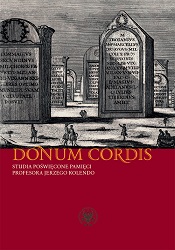„Inwentarze” Pana Antoniego
The “inventories” of Mr. Anthony
Author(s): Mariusz Mielczarek
Subject(s): Archaeology
Published by: Wydawnictwa Uniwersytetu Warszawskiego
Keywords: Jerzy Kolendo; archaeology; Poland; Europe; University of Warsaw; Polish Academy of Sciences
Summary/Abstract: The principles of “library archaeology,” propagated by Professor Jerzy Kolendo, produce interesting resultsalso in cases relating to the middle of the previous century. An example of this is Anthony Klein’s (1901–1968)collection of ancient coins, assembled in the Middle East during the Second World War. It is one of the mostvaluable assemblages acquired by Polish soldiers in the Middle East in the 1940s (currently housed at the Museumof Archaeology and Ethnography in Łódź). Klein’s archaeological experience resulted in him writing down thedata on the places where the coins had been found, including two treasures of ancient coins.The high value of the numismatic collection of Anthony Klein has risen signifi cantly in connection to the“inventories” compiled by him, which were forgotten for many years and have now been brought to light. Theyare meticulously made lists, drawn up not long after Klein’s return to Poland in 1947. The “inventories” confi rmwhat was already known about the place where the coins had been found, but they also signifi cantly enrichthe accounts contained in the museum documentation. They include, among others, precise information on theplace and the circumstances of the discovery of many of the objects, provided with Anthony Klein’s considerablearchaeological knowledge and rich experience in this respect.The character and the contents of the “inventories,” thanks to more detailed records than the ones knownbefore, allow scholars to more precisely defi ne the fi nding place of individual coins, or treasures, and to pointto the circumstances of their discovery. Klein has only described two fi nds as treasures. Taking into account hisknowledge and experience in assessing fi nds (calling them explicitly “surface fi nds”), there are no grounds todoubt the designation of the type of fi nd. In the “inventories” there also appears the term “found in the culturallayer.” For example, “Jaffa / from the cultural layer / from the ruins of the city,” “Emmaus / surface / in a fi eld Eof the village of Emmaus” or “Greek coin from the 4th century BC” found “in the ruins on the coast of theMediterranean Sea between Tel Aviv and Apollonia.”In the light of the records included in the “inventories,” a new study of the “Palestinian” collection of AnthonyKlein is necessary. The coins assembled by him have become a valuable source for research on the circulation ofmoney in Palestine.
Book: Donum cordis. Studia poświęcone pamięci Profesora Jerzego Kolendo
- Page Range: 259-270
- Page Count: 11
- Publication Year: 2019
- Language: English, Polish, German
- Content File-PDF

